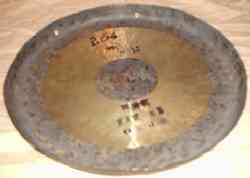Gong facts for kids
A gong is a musical instrument from East and Southeast Asia. It is a round, flat piece of metal. People play it by hitting it with a special mallet or a thick, soft stick. Gongs are part of the percussion instrument family.
What is a Gong?
Gongs are usually shaped like a disc or a bowl. They are made from metal. When you hit a gong, it makes a loud, ringing sound. This sound can be very powerful and deep.
How Gongs Sound
Gongs can make two main types of sounds.
- Some gongs have a flat surface. These gongs make a loud "crash" sound. It is like a big, sudden noise.
- Other gongs are made to produce a specific musical note. These notes can be very low. In Indonesia, gongs are often used in special music groups called gamelan ensembles. Some gongs in these groups make a deep, humming sound that vibrates very slowly.
The word "gong" is used for both the crashing type and the note-making type of instrument.
Where Gongs Are Used
Gongs are very important in the music and cultures of many Asian countries.
- In Indonesia, gongs are a key part of traditional gamelan orchestras. These orchestras play music for dances, puppet shows, and ceremonies.
- Gongs are also used in China, Japan, Korea, and other countries. They can be found in temples, for celebrations, or in modern orchestras.
- Some gongs are very large and can create a huge, echoing sound.
Images for kids
-
A gong shown on 15th-century temple carvings at the Candi Sukuh in Central Java, Indonesia.
-
An agung, which is a type of hanging gong from the Philippines. It is used in Kulintang music.
-
A Pande (Gamelan Maker) is heating a gong in Besalen in Central Java, Indonesia.
-
A Gong ageng in a Javanese Gamelan music group.
See also
 In Spanish: Gong para niños
In Spanish: Gong para niños












